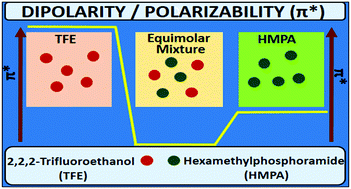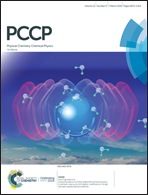Probing interactions within liquid media via a model H-bond donor–acceptor mixture†
Abstract
Understanding interactions within liquids so as to obtain desired physicochemical properties is of utmost importance in chemistry. Solute–solvent and solvent–solvent interactions within mixtures of hexamethylphosphoramide (HMPA) and 2,2,2-trifluoroethanol (TFE) are assessed using various invasive and non-invasive techniques. HMPA and TFE possess similar static dielectric constants. While HMPA has high H-bond accepting basicity (β ∼ 1) and no H-bond donating acidity (α ∼ 0), TFE has high H-bond donating acidity (α ∼ 1) and almost no H-bond accepting basicity (β ∼ 0). Kamlet–Taft parameters obtained using solvatochromic UV-Vis molecular absorbance probes suggest α and β of the (HMPA + TFE) mixture to be higher than those expected from mole-fraction weighted ideal-additive values with α and β exhibiting synergism in TFE-rich and HMPA-rich regions where α > 1 and β > 1, respectively. HMPA has lower dipolarity/polarizability (π*) than TFE, however, the addition of TFE to HMPA results in even further lowering of π* implying significant non-polar nature of the (HMPA + TFE) mixture as compared to its neat constituents. Photoinduced charge-transfer (neutral and anionic) and ratiometric solvatochromic fluorescence polarity probes also confirm the mixture dipolarity to be significantly lower than that expected. FTIR absorbance and Raman spectroscopic measurements hint at the weakening of the strong H-bonds among TFE and/or HMPA as the two solvents are mixed. Positive excess molar volumes (VE) and excess logarithmic viscosities [(ln η)E] indicate weakened interactions in the (HMPA + TFE) mixtures as compared to the interactions within neat TFE and neat HMPA. Microfluidity of the mixture obtained from an intramolecular excimer-forming fluorescence probe further supports these outcomes. Formation of a low polarity liquid milieu upon mixing of two higher polarity solvents is amply highlighted.

- This article is part of the themed collection: 2019 PCCP HOT Articles

 Please wait while we load your content...
Please wait while we load your content...